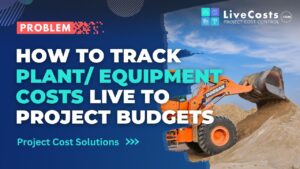Accounts payable in construction refers to the money due to suppliers and subcontractors. It includes all types of costs, such as overhead, direct and indirect. The accounts payable function is processing, verifying, reconciling and paying invoices in an appropriate amount if time. In construction the role can be extended to matching invoices to Purchase Orders and Deliveries.
For many small businesses, Microsoft Excel (or Google Sheets) is the default choice for bookkeeping. This is especially true for new small business owners. However, as your business begins to grow, you’ll quickly realise that you don’t have the time to deal with the manual labour required to maintain Excel. You’ll soon be faced with a business decision — should you spend time and effort dealing with MS Excel and the risks associated with it? Or should you transpose all of your business’s financial information into a software?
Let’s take a look at these problems in more detail.
Time Consuming
Unfortunately, Excel (or Google Sheets) entry and maintenance requires a lot of working hours. Accounts payable need to enter every business expense by hand when their time could be spent doing far more important and impactful tasks for the business. Excel accounting spreadsheets also don’t store historical data very well. Microsoft didn’t design these spreadsheets to hold years’ worth of information. This can mean spending hours looking for older excel sheets (that may have been deleted) to report on older costs, not very helpful in the case of an audit.
The financial data entered into excel also doesn’t contain the source document meaning you may have to print or create folders to store the invoices and receipts elsewhere. Again not very helpful when trying to track down an input error.
Excel might work when you first start your business. But as your company grows, things change. You might hire new people. Before you know it, your spreadsheet can’t keep up with your business finances.
Spreadsheets slow people down because of its manual and repetitive nature. Automating the entire process would mean that people can spend more time doing important tasks, less mistakes are made and everybody is working from the same version in whatever system is being used.
Allows For Human Errors
Spreadsheet errors tend to have a compounding effect. One incorrect cell in your spreadsheet can have huge repercussions down the line. Mess up one input with an incorrect digit, or misplaced comma or decimal point, and your spreadsheet will use that to miscalculate other computations.
Correcting errors can be frustrating and time consuming. Most spreadsheets contain some form of error, when you add multiple people into the mix and a couple of versions, can you ever be truly confident that what you’re looking at is accurate?
If you are using a spreadsheet, backing up and restoring data can become an issue. While typing and processing data in your spreadsheet if you are not continuously saving, a sudden failure of electricity or the crashing of the hard drive may become a nightmare.
Not Secure
Lack of storage and data protection can be concerning for construction companies that use spreadsheets for accounts payable. Spreadsheets are notoriously un-secure. Anyone who gets access to the spreadsheet, has complete access to your accounting information. There are no passwords, internal controls, or user rules preventing people from viewing, stealing, or altering accounting data. Data breach can be very costly.
Spreadsheets do provide workbook password-based protection, cell locking and hiding of formulas but the level of protection is relatively low, provides a first line of defence only, which can all be broken fairly easily. They don’t match the higher level of security found in cloud based automation & accounting softwares.
No Automation
One of the reasons spreadsheets fall to financial errors is their lack of automation. The time spent manually updating and monitoring spreadsheets can leave inconsistencies in the system. Missing one correction or not updating a single formula will leave the data flawed. There is no functionality to update relevant account information, or rules in place to moderate the kind of data entered. However, automation in modern softwares update your data in real-time. With OCR invoice scanning, manual data entry and the errors that occur can be minimised.
Improving Accounts Payable
Have an email address that all invoices are sent to
In order to prevent confusion with suppliers about who is to receive invoices, have one designated email address in which all invoices are sent to. This will also make it a lot of easier for keeping track of invoices received.
It should be encouraged that your suppliers email invoices instead of sending paper copies. Emailed invoices can easily be recalled and referred to if there are any issues.
Enter all invoices into a cost tracking software
Invoices should be logged in some form of cost tracking software. Every incoming costs should be categorised and allocated to a projects budget.
Entering invoices as they come in creates a record showing that the invoice exists and has been placed against the correct project budget. All historical costs are available going forward as reference for future costs.
Eliminate paperwork
Instead of keeping paperwork, send copies of accounts payable invoices to a cloud storage system. By doing this, it’ll ensure there’s always a copy of every invoice.
Construction software has come a long way in recent years, taking advantage of this is essential to staying on top of costs. Accounting softwares may offer some form of approval system but they’re not built for construction, they won’t associate invoices to a project or phase. For this, a construction cost tracking software is needed.
These processes reduce the chance of lost invoices and help ensure that all costs are recorded in a cloud based system.
Determine cashflow needs
Many software’s will allow payment due dates to be entered for accounts payable invoices.
By reviewing the amounts due on a certain date, this will allow accurate cash flow projection to be made, showing how much is due on a weekly or monthly basis. This will allow a construction company know how much cash they need to cover their project costs.
Schedule payments
Sticking to a regular payment schedule is important. Set specific days of the week or month where payments are made on invoices that are due.
Invoices have different due dates, reviewing these determine when is the best time to make payments. Once a week is a good place to start, as this allows to address urgent payments.



